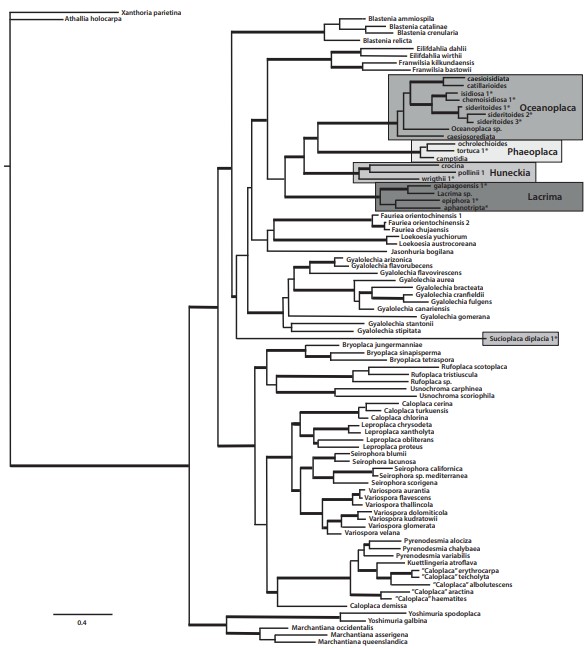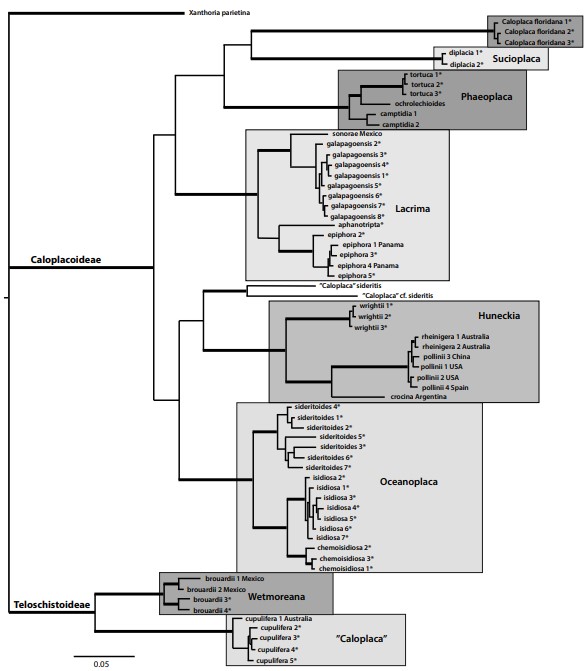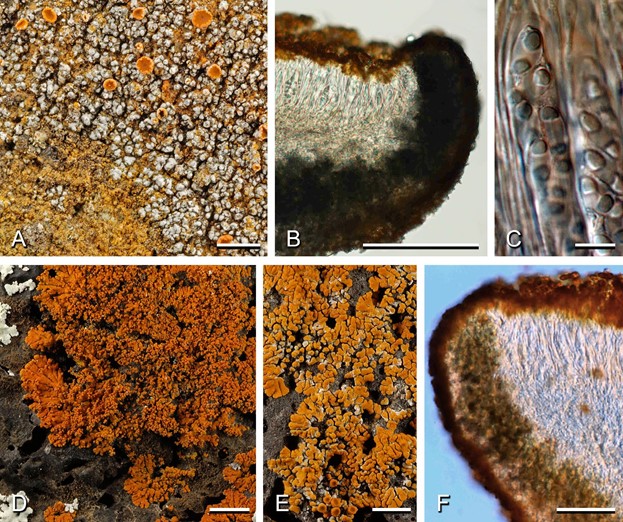Oceanoplaca isidiosa (Vain.) Bungartz, Søchting & Arup, comb. nov. (Figs 1–2, 10D–F)
MycoBank number: MB 836944; Index Fungorum number: IF 836944; Facesoffungi number: FoF 13609;
Basionym: Placodium isidiosum Vain., Étud. Class. Lich. Brésil 1: 118. 1890; MycoBank MB 533770.
Description. Thallus placodioid, of convex, ± elon- gate-radiating areoles in the center and ± convex, wide- ning to fan-shaped, ~0.2 mm broad lobes along the periphery, individual thalli up to 2.5 cm in diam., but several thalli frequently confluent, merging with one another; hypothallus and prothallus absent; surface strongly yellow orange to deep reddish orange, not shiny, or with a faint, farinose orange, or rarely whitish pruina, particularly in the center densely isidiate; isidia initially ± papillate to nodular, granular-globose, but soon broadly cylindrical to coarsely coralloid, 0.1–0.2 mm thick. Apothecia frequently absent or poorly developed, the thallus then densely isidiate; if present, sparse to numerous and interspersed with isidia, not closely grouped, sessile to slightly stipitate, 0.6–0.8(–1) mm in diam., lecanorine; thalline margin thick, ~150 µm and prominent, often curved inwards and soon strongly crenate, circular to soon flexuose, strongly yellow orange to deep reddish orange, concolorous with the thallus, epruinose to rarely sparsely whitish pruinose, C−, K+ purple, proper margin absent or not clearly differentiated; disc deep orange, concolorous or darker than the thallus, initially concave, later flat, epruinose to rarely sparsely whitish pruinose, C−, K+ purple; epihymenium with orange pigment granules, C− (±orange red intensifying), K+ purple, contiguous with the outer exciple; hymenium hyaline, not inspersed; proper exciple absent (completely reduced); thalline exciple differentiated into a broad inner part abundantly filled with large trebouxioid photobionts and few, small, colorless crystals, dissolving in K, and an outer part, with orange pigment granules, C− (±orange red intensifying), K+ purple; subhymenium and hypothecium not differentiated, hyaline, not inspersed; asci clavate, Teloschistes-type; ascospores 8/ascus, polaribilocular, ellipsoid to broadly ellipsoid (8.3–)9.2–11.6(–13.1) × (4.6–)5.4–7.6(–9.2) µm, with a moderately thickened, (1.9–)2.4–3.7(–4.3) µm wide septum (n = 34). Pycnidia not observed.
Chemistry. Thallus and apothecia P–, K+ purple, C–, KC+ purplish (fading), UV– (dull); with abundant amounts of isidiosin.
Ecology and distribution. Originally described from Brazil (Vainio 1890) and first reported from Galapagos by Weber (1986). It is a common species on mostly sunny, wind- and rain-exposed rock, less common in ± sheltered, semi-shaded habitats, especially near the coast, less common throughout the dry and lower transition zone, rarely also into the humid zone.
Notes. Even though O. isidiosa is morphologically very variable, fertile specimens with conspicuous whitish pruina covering the marginal lobes, in the center less distinctly isidiate, but instead with large, nodular apothecial initials, were initially considered to represent a separate species. This hypothesis was not confirmed by the phylogenetic analyses. ITS sequences of the Galapagos specimens are all very uniform and well separated from its sister O. chemoisidiosa, with which the species shares the secondary metabolite isidiosin (for more detail see the description there). Weber originally annotated the pruinose specimens as ‘Caloplaca saxicola’, but never published these annotations and the name ‘Caloplaca saxicola’ was never included in his checklist (see list of species that do not occur in Galapagos).

Figure 1. Three-gene tree (nrITS, nrLSU and mrSSU) of the subfamily Caloplacoideae, with the species reported from the Galapagos highlighted. Nodes supported by posterior probabilities higher than 0.95 are in bold. Sequences generated from Galapagos material are marked by an asterisk*.

Figure 2. Phylogenetic nrITS tree of species from the subfamily Caloplacoideae and Teloschistoideae in the Galapagos, emphasizing the relationship of the newly described genera Lacrima, Oceanoplaca, Phaeoplaca, and Sucioplaca. Nodes supported by posterior probabilities higher than 0.95 are in bold. Sequences generated from Galapagos material are marked by an asterisk*.

Figure 10. Species of Oceanoplaca with isidiosin. A–C – Oceanoplaca chemoisidiosa. A – pale gray, ± pruinose bullate-areolate thallus, apothecia orange, sessile, crenate margin paler and more distinctly pruinose than the disc (Bungartz 6417, CDS 34632–holotype); B – apothecial section: lecanorine, outer exciple and epihymenium abundantly filled with orange-brown granules, inner exciple filled with a mixture of small, gray crys- tals obscuring the green photobiont cells [DIC, in water] (Bungartz 6436, CDS 34651); C – asci with oblong ascospores, septum broad [DIC, in water] (Bungartz 6417, CDS 34632–holotype). D–F – Oceanoplaca isidiosa. D – placodioid-lobate, deep reddish orange, strongly isidiate thallus (Bungartz, F. 5211, CDS 29424); E – placodioid-lobate, strongly yellow orange, sparsely papillate-isidiate thallus (Bungartz, F. 6036, CDS 33715); F – apothecial section: lecanorine, outermost exciple and epihymenium deep orange, inner exciple abundantly filled with trebouxioid green algae [DIC, in water] (Bungartz, F. 5281, CDS 29497). Scales: A, D–E = 2 mm; B, F = 100 µm; C = 10 µm.
